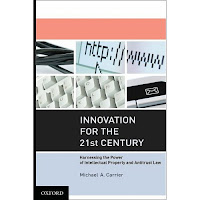 ‘Innovation for the 21st Century, Harnessing the Power of Intellectual Property and Antitrust Law’ by Michael A. Carrier. Oxford University Press.
‘Innovation for the 21st Century, Harnessing the Power of Intellectual Property and Antitrust Law’ by Michael A. Carrier. Oxford University Press.
Professor Michael Carrier of Rutgers University School of Law, wrote an excellent book about intellectual property rights (IPR) law and antitrust law, the intersection between the two disciplines and how both systems can be improved. IPR and antitrust law have the same goal, but use opposite methods: where IPR law grants, protects and enforces monopolies that give positive incentives to innovation, antitrust law is trying to avoid and combat monopolies that give negative incentives to innovation. Not only does Mr Carrier explains in a very clear language with a lot of good examples what the problems are, regarding patents, trademarks and copyrights, but he also comes up with ingenious, concrete and concise answers. In fact he comes up with ten revolutionary (which is defined in the I Ching as “fire ignites within the lake, defying conditions that would deny it birth or survival”) proposals to resolve the biggest problems of the US IPR-antitrust system.
To some degree these solutions could be applied to other jurisdictions, such as China (innovation is crucial for China’s economic growth), as well. Let’s look at his proposal to reduce invalid patents, which could limit competition and thus increase price which leads to adverse effects on innovation and complicated, complex and expensive antitrust cases. Bad patent award legal rights that are far broader than what their relevant inventors invented, in regard to technologies that are economically significant:
“1. A post-grant opposition system that would allow any party to challenge a patent after it is issued. This would target the most valuable patents and provide a quicker and cheaper determination of validity that litigation.”
Advantages:
- Instead of perfecting the application process, post-grant opposition makes use of the knowledge of competitors and patent applicants;
- Litigation is costly, skewed incentives (patentees spent more than infringers and a successful validity challenge benefits all infringers so you get a free-rider problem);
- Reexamination (limited participation for requesters as well as estoppel provisions);More information can lead to higher quality patents;
- Post-grant does not require early disclosure: there is no risk that sensitive information fill fall into the hands of competitors.
Disadvantage:
- Mark Lemley, Douglas Lichtman and Bhaven N. Sampat propose in their 2005 article ‘What to do about bad patents?‘ (free download at SSRN via pdf) also the post-grant opposition system. They also warn about the risk of collusion: “If an applicant can get a buddy to raise a straw man challenge to his patent and, through that, walk away with a stronger presumption of validity, the whole process will collapse.”
Could this be applied to China’s patent system? Like many countries the China Patent Office has the problem of issuing invalid patents. Valid patents could foster innovation, while invalid ones “threaten to increase price and limit competition without any countervailing benefits”, according to Carrier.
1984 Patent Law: First China had an pre-grant opposition procedure (sometimes also called dissenting procedure). Before patents were granted the China Patent Office would publish them three months before, so any person could lodge their opposition at the China Patent Office. If at the end of the three month period no opposition procedure was filed, the patent was granted. Any person could initiate an invalidation procedure at the Patent Re-examination Board (PRB).
1992 Patent Law: Post-grant revocation procedure was set up. Within six months after the grant of patent anyone could request the Patent Office to revoke the patent (article 41). The patentee or the requester of the revocation procedure can file a request for re-examination of the decision at the PRB. The decision (invention patent, but not utility patent nor design patent) of the PRB can be appealed at a People’s court within three months. After the six months after the grant of a patent had expired any person could use the invalidation procedure at the PRB to invalidate the patent. The decision of the PRB (invention patent, but not utility patent nor design patent) can be appealed at the People’s court within three months.
2000 Patent Law: Post-grant revocation procedure was eliminated. A change in the invalidation procedure is that the PRB decision regarding utility patent and design patent can now also be appealed at a People’s court within three months.
2008 Patent Law: Invalidation procedure Every patent infringement case is met by an invalidation procedure.
China never had a post-grant opposition. However, they had a pre-grant opposition system, but because there were few oppositions and they wanted to shorten the examination time and quicken granting of patents, they god rid of it. The last two reasons could also be solved by implementing a post-grant examination. Mr Carrier’s book is interesting and can be read by a wider audience interested in patent reform. China’s Third Amendment to its Patent Law did not make any great changes in its patent prosecution provisons. Maybe, some of Mr Carrier’s lessons will be taken into account for the next amendment.
Illuminating book for everyone interested in innovation and the IPR and antitrust systems that can harness it.
